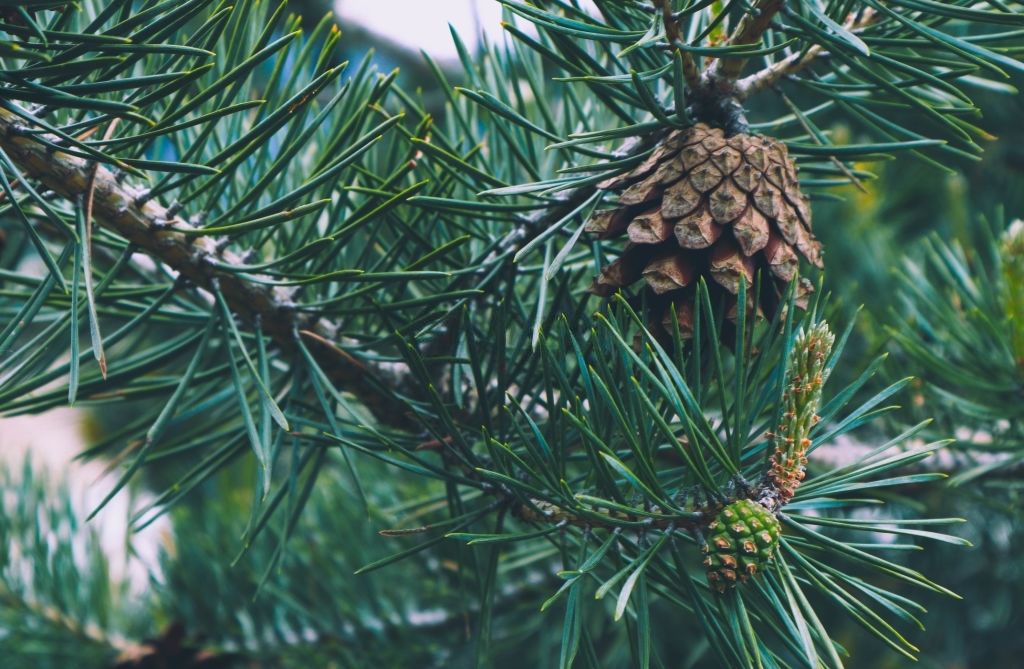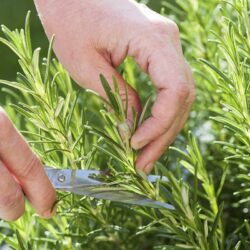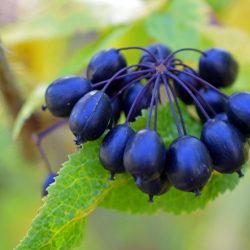Scots pine, whose botanical name is Pinus sylvestris L., belongs to the Pinaceae family. Its essential oil is obtained from the needles. The origin of Scots Pine’s Latin name is debated. Alexandre Etienne Guillaume “de” Théis, in 1810, maintained that it comes from the Celtic “pinus”, meaning mountain or rock. However, Félix Gaffiot, in his 1934 French Latin Dictionary, thought it derived from the Latin “pinus”. This Latin word would be linked to the ancient Greek “pitus” or “pitta”, meaning pine or resin. Despite these uncertainties, one thing is clear: its forest habitat justifies its name “sylvestris”. This term comes from the Latin word “silva”, meaning forest.
What is the Scots pine?
Scots pine(Pinus sylvestris) is a species of tree native to the mountainous regions of central and northern Europe. It is common and adapts well to a variety of environments, dominating the boreal forests of Eurasia. This pine has a long trunk without branches. It normally lives for 150 to 200 years, but can reach 600 years. It grows to between 25 and 40 metres tall. Its bark is orange or yellowish-grey at the top.
Scots pine leaves are relatively short needles, measuring 4 to 7 cm on mature trees. They are grouped in pairs with a common base and have a characteristic bluish-green or greyish-green tinge.
The plant has a wide distribution. It ranges from Mediterranean to subarctic regions. It is found in a variety of forest habitats, from mountains to plains.Scots pine plays a major role in forestry and reforestation. It is often planted outside its native range. This has led to its naturalisation in some regions. It is well adapted to light and is resistant to wind and drought. Although it can thrive in a variety of soils, it prefers non-calcareous soils.
As far as conservation is concerned, Scots Pine is not considered to be a threatened species in France and is classified as a Species of Least Concern (LC) by the IUCN.
A little history
A mythical tree in the Far East, it symbolises life, longevity and immortality. In Scotland, it has been elevated to the rank of national tree. For centuries, pine has been used for its therapeutic properties. Pine needle extracts were traditionally used by the Amerindians of Canada to prevent scurvy. This is what French explorer Jacques Cartier discovered when he first explored the Gulf of St. Lawrence in 1534.
Hippocrates used its oleoresin to treat pneumonia and infectious respiratory diseases. Dioscorides recommended a decoction of pine cones in wine to combat inveterate coughs in patients with tuberculosis and ulcerated lungs. He also cites Scots pine as a remedy for respiratory diseases, sore throats and congestion. Theophrastus of Eresis, a disciple ofAristotle, wrote at length about it in his treatise on plants.
The name “pine” has given rise to some debate about its origin, with some suggesting that it derives from the Indo-European word “pit” meaning resin, while others believe that it comes from the Celtic word “pen” meaning head, in reference to the resin. “Pinus” in Latin refers more specifically to the umbrella pine, while “sylvetris” comes from the Latin “sylva” meaning forest. In mythological terms, the pine is associated with various nature deities, such as Pan in Greek mythology and Sylvain in Roman mythology. Pines were sacred in ancient Greece, and felling them was forbidden.
Pine nuts are also linked to mythology as an avatar of the Mother Goddess, Cybele, representing the energy of the earth. They were considered to have an aphrodisiac effect, although this has not been scientifically proven.
In the Middle Ages, pine trees were associated with magic and medicine. Merlin climbed a pine tree to acquire powers, and Hildegarde de Bingen recognised the medicinal value of pine resin, but warned against using it exclusively.
During the Renaissance, Jacques Cartier learned from native Canadian tribes that pine needles had antiscorbutic properties, helping to prevent this disease among sailors.
The use of pine buds appears to be more recent in Europe. Fournier (20th century) considers it to be balsamic, pectoral, diuretic, anti-corbustic and more or less bactericidal, making it a remedy for chronic or acute bronchitis, coughs, influenza, asthma and urinary disorders such as cystitis or stones. Applied topically, it is useful for skin diseases, rheumatism and stimulating blood circulation. Modern and contemporary times have also seen the continued use of pine resin for medicinal purposes, particularly in the treatment of respiratory ailments and skin problems.
What are the main pharmacological properties of pine buds?
Scots pine mainly contains phenolic acids and an essential oil rich in pinenes. These components give it beneficial properties for the respiratory tract, particularly as a respiratory antiseptic, expectorant, mucolytic and anti-inflammatory.
Known or presumed mode of action :
- Alpha-pinene and beta-pinene, limonene are expectorants
- Bornyl acetate is a central and peripheral analgesic
- Monoterpenes are cortisone-like
The German Commission E recognises the use of Scots pine buds in the treatment of catarrhal affections of the respiratory tract, emphasising their effectiveness (97). The antiseptic benefits for the respiratory tract are attributed to the presence of α-pinene and β-pinene in the plant. These compounds stimulate the mucus-eliminating activity of the respiratory cilia, thereby promoting the expulsion of bronchial mucus (58) (62).
Respiratory tract antiseptic properties
Scots pine (Pinus sylvestris) is a tree with medicinal properties attributed to its essential oil, which is rich in compounds such as α-pinene, β-pinene and limonene. These components give Scots pine important therapeutic properties, particularly in the field of respiratory health and infection control.
One of the main properties of Scots Pine is its expectorant effect. This means that it promotes the expulsion of bronchial secretions, which can be very beneficial for people suffering from hacking coughs or lung congestion. By making it easier to clear the airways, it helps relieve the symptoms of various respiratory ailments, particularly bronchitis.
Antimicrobial, Scots pine oil has pulmonary antiseptic effects. The antibacterial activity ofα-pinene has been demonstrated against staphylococcus aureus,Escherichia coli, Proteus mirabilis, Pseudomonas aeruginosa and Klebsiella pneumoniae .
In addition, Scots pine is renowned for its antiseptic and antibacterial properties. It has the ability to inhibit the growth of pathogenic bacteria, in particular Staphylococcus aureus, a Gram-positive bacterium. Its antibacterial action is known as “bacteriostatic”, which means that it prevents the multiplication of bacteria, helping to combat respiratory infections and other health problems.
In particular, pine potentiates the antibiotic effect of tetracycline on Staphylococcus aureus.Alpha-pinene modulates antibiotic resistance in Campylobacter jejuni. This molecule reduces the minimum inhibitory concentration of antibiotics (ciprofloxacin, erythromycin, triclosan). It also inhibits microbial efflux pumps and alters membrane integrity and microbial metabolism.
The effect of the antibiotics ceftazidime, amoxicillin, cefepime, cefoxitin and amikacin on Escherichia coli is potentiated.
In addition to its action against bacteria, Scots pine also has antifungal properties. It is effective against several varieties of fungi, such as Aspergillus and Penicillium. These antifungal properties are important for improving indoor air quality, particularly in environments where mould proliferation can be a problem. Antifungal against Candida albicans and dermatophytes, the essence is also antiviral against the herpes virus HSV-1.
Expectorant and mucolytic properties
The power of this plant comes from its composition, which is rich in monoterpenes such as α-pinene, β-pinene and turpentine.
- Expectorant and liquefying,α-pinene thins mucus, making expectoration easier.
One of the most remarkable aspects of this plant is its ability to stimulate the mucin glands. As a result, it increases the production of secretions in the respiratory tract. These secretions play an essential role in keeping the respiratory tract healthy, as they act as a trap for dust, bacteria and foreign particles. However, when the mucus becomes too thick, it can obstruct the airways and cause breathing problems.
That’s where Scots Pine comes in. By thinning mucus, reducing its viscosity and improving its elasticity, this plant helps to eliminate mucus. This action is essential because it enables the ciliary movement to expel secretions more effectively, helping to clean the respiratory tract. In addition, Scots Pine is beneficial when there is damage to the mucociliary carpet, which is responsible for moving secretions through the airways. It helps restore this crucial function.
As a result, Scots Pine has antitussive properties, meaning it soothes coughs by reducing irritation of the respiratory tract. It is also considered an emollient, softening the respiratory tract by reducing inflammation. As a result, it offers relief to cough sufferers, particularly those with bronchitis and wet coughs.
Anti-inflammatory and decongestant properties
One of the most notable discoveries concerns the impact of Scots pine extract on the production of nitric oxide (NO). In vitro studies suggest that this extract reduces NO production, mainly due to two possible mechanisms. Firstly, it may have inhibitory effects on the expression of the inducible nitric oxide synthase (iNOS) gene, an enzyme responsible for NO production. On the other hand, it may have the capacity to eliminate existing NO directly. This regulation of NO is crucial, as excessive NO production is associated with inflammation.
In addition, Pinus sylvestris bark extracts have an inhibitory capacity in vitro. They act on inflammatory mediators such as NO and PE2. Polyphenols, including taxifolin and procyanidins, encourage apoptosis. This is a programmed cell death process essential for eliminating damaged or superfluous cells.
Scots pine also has anti-inflammatory properties. It has traditionally been used as a decongestant for the pelvic area. This includes the bladder and the utero-ovarian sphere, as well as the lymphatic system. It is recognised for its anti-inflammatory and analgesic potential in the treatment of rheumatic conditions.
But Scots Pine’s beneficial action doesn’t stop there. It also acts as a decongestant for the upper respiratory tract, soothing the symptoms of respiratory ailments. Its particular tropism for the bronchopulmonary sphere makes it invaluable in cases of hacking cough, inflammation of the airways and even chronic obstructive pulmonary disease (COPD). Scots pine buds offer relief by soothing the respiratory tract thanks to their anti-inflammatory activity. They play an essential role in relieving throat irritation, clearing the nose and making breathing easier.
Scots pine essence has an adrenergic and chondroprotective stimulating action .
Other effects:
- Hormone-like
- Pituitary-cortical-adrenal axis: cortison-like, anti-inflammatory
- pituitary-pancreatic: anti-diabetic
- pituitary-gonadal: sexual stimulant
- Pituitary-cortical-adrenal axis: cortison-like, anti-inflammatory
- Stimulating neurotonic and hypertensive tonic (the greatest physical tonic)
- Balsamic, bronchial fluidifier
- Lymphatic and utero-ovarian decongestant
- Active on the ANS: Ʃ
- Antispasmodic of β-pinene
- Stimulates digestive microcirculation
- Rubbing, percutaneous analgesic
- Healing and local anti-inflammatory
Are there any precautions to be taken when using Scots Pine?
To date, there have been no reports of toxicity associated with the use of Scots Pine.
To date, no side effects have been reported from the use of Scots pine.
No drug interactions associated with Scots pine are known to date. The French National Agency for Food, Environmental and Occupational Health and Safety (ANSES) has not issued any specific recommendations concerning the use of food supplements containing Scots pine.
- Avoid in combination with cortisone, risk of drug interaction
- Also contraindicated for those hypersensitive to its active ingredients
- Do not use over a prolonged period, as there is a risk of resting the pituitary-adrenal axis and suffering acute adrenal insufficiency if you stop taking the essential oil
- Avoid applying the essential oil in the evening (or before any period of rest)
- Not recommended for people suffering from osteoporosis, due to the inherent risk of decalcification
- Dermocaustic in its pure state, dilution required
- Avoid wet inhalation
- Epileptic in high doses
- Contraindicated in children under 7 years of age
- Contraindicated in pregnant women ( limonene induces uterine contractions) and breastfeeding mothers. It should also be avoided during the first 5 months of pregnancy.
- Caution in cases of renal insufficiency per os (nephrotoxic)
- Α-pinene is an enzyme inhibitor, risk of drug interactions, ask your pharmacist for advice
- Contraindicated in asthmatics and in cases of asthmatic cough.
- Experts advise against the use of Scots pine buds by children under 2 years of age and those who have had convulsions.
How to take Scots Pine and at what dosage?
The dosage of Scots Pine varies according to its form (essential oil, extract, supplement). The purpose of use also influences the dosage. Following the advice of the manufacturer or a health professional is crucial. Dosages differ according to the concentration and purity of the product.
Scots pine essential oil is highly concentrated and powerful. It must be diluted before use. In general, you can add a few drops of Scots pine essential oil to a carrier oil (such as sweet almond oil or coconut oil) before applying it to the skin or inhaling it. The specific dosage will depend on the intended use, but always start with a small amount and increase if necessary.
Scots pine extracts may be available in various forms (capsules, drops, etc.). Dosages may vary depending on the manufacturer and the concentration of the extract. It is essential to follow the instructions on the product packaging or consult a healthcare professional to determine the appropriate dosage for your specific needs.
If you are considering taking dietary supplements containing Scots pine, follow the manufacturer’s recommendations on the product packaging. Dosages may vary from one supplement to another, so be sure to follow the instructions for safe and effective use.
- Standardised fresh plant fluid extract: 5 ml once or twice a day in a glass of water.
- Hydroalcoholic extract: 15 to 20 drops 2 to 3 times a day in water.
- Herbal teas: infuse 4 grams of bud per 200 ml for 1 hour and filter. One cup 2 to 3 times a day.
- In the form of standardised fresh plant extract or powder, in capsules: 150 to 200 mg per dose, taken 1 to 2 times, 2 to 3 times a day.
- Essential oil: orally, 2 drops, 2 to 3 times a day
Medical literature and clinical trials
- Rauha J.P. et al, Antimicrobial effects of Finnish plant extracts containing flavonoids and other phenolic compounds, Int J Food Microbiol, 2000
- Motiejunaite O., Peciulyte D., Fungicidal properties of Pinus sylvestris L. for improvement of air quality, Medicina (Kaunas), 2004
- Karonen M. et al, Phenolic Extractives from the Bark of Pinus sylvestris L. and Their Effects on Inflammatory Mediators Nitric Oxide and Prostaglandin E2, J. Agric Food Chem, 2004
- Kizilarslan Hancer C. et al, Ethnobotanical uses of genus Pinus L. (Pinaceae) in Turkey, Indian Journal of traditional knowledge, 2013
- Amalinei R.L.M. et al, Polyphenol-rich extract from pinus sylvestris l. bark – Chemical and antitumor studies, Rev. Med. Chir. Car. Soc. Med. Nat, Iasi, 2014







